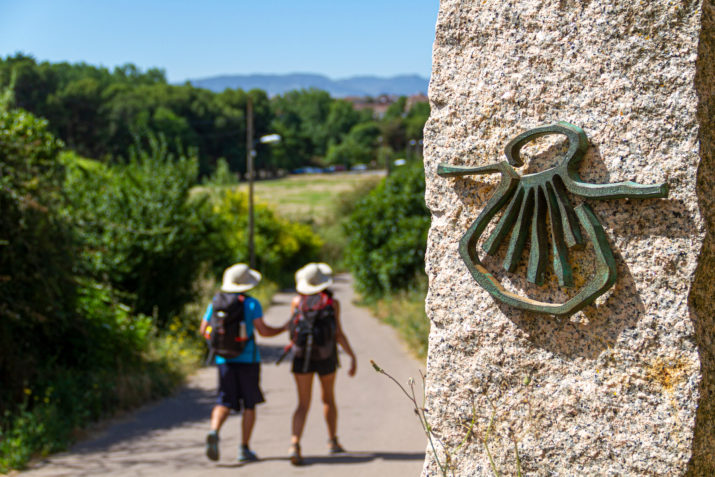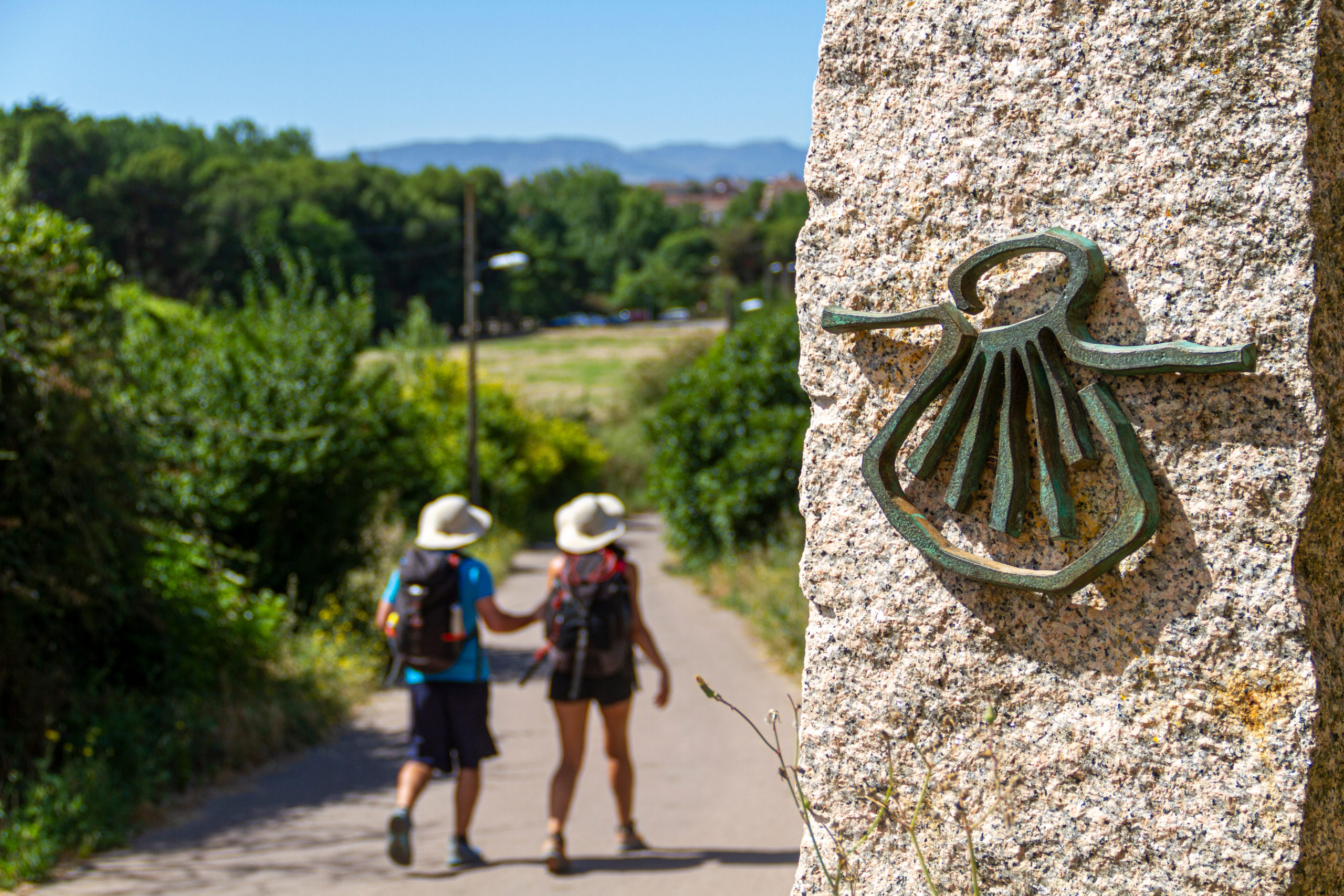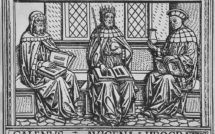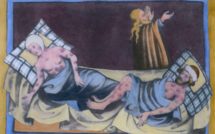

This is part of our Campus roundtable on Teaching Medieval in Modern Plague Times.
The Camino de Santiago, the Way of St. James, is a network of pilgrimage routes that extends from its endpoint in northwest Spain throughout Europe. It has experienced a surge of global popularity since the late twentieth century thanks in part to movies like The Way and high profile descriptions by writers as diverse as Paulo Coelho and Shirley MacLaine.[1] The most famous part of the Camino, the camino francés or French Way, stretches nearly 800 kilometers west from Saint-Jean-Pied-de-Port, over the Pyrenees, and across northern Spain to the city and cathedral of Santiago de Compostela, where the bones of the apostle James the Greater are venerated. In Spring 2020, I was teaching a course on this pilgrimage route, and on medieval and modern pilgrimage in general, which was to culminate in a two-week walk in May along the last 300 kilometers from León to Santiago. It was my second time teaching the course, which I also taught last spring. Spring 2020 presented us all with a series of challenges, large and small, in our professional as well as our personal lives. For me, the general difficulty of pivoting a course online with very little notice was naturally compounded by the significant study abroad component. More than that; the physical experience of the walk, so central to the course, was irreplaceable; or so I thought.
The Camino class at Fordham (Medieval Studies 4998: Study Tour: Medieval Spain) is something of an institution, whose fame has spread among students mostly by word of mouth. Professor Richard F. Gyug (emeritus, History and Medieval Studies) first took a group of students on Camino in 2007, and he or Professor W. David Myers (History) have done so nearly every year since then. The course is an interdisciplinary capstone intended to allow students to reflect on their college experience, with readings that range from medieval pilgrimage narratives to Nancy Frey’s Pilgrim Stories (the work of a sociologist turned tour guide who settled down in Galicia).[2] After sporadic meetings during the spring semester, in May comes the walk itself: the students carry packs, walk an average of fifteen miles each day, and sleep in hostels each night, with additional discussion, instruction, and presentations along the way.
If the course format is unusual, so is the process by which students enroll in it. The instructors spend a few months during the fall semester selecting students through a fairly competitive interview process, capping the group at fifteen juniors and seniors (in fall 2019, we interviewed upwards of seventy students for these fifteen slots). By design, most of these students have never had classes with one another; most are not medievalists; many of them have never met until this class. They are drawn more or less equally from Fordham’s two New York City campuses (Rose Hill in the Bronx, and Lincoln Center in Manhattan), which are host to two very different student populations that do not often mix. This year, we had students from many different departments: International Political Economy, Business-Marketing, History, Neuroscience, Medieval Studies, Journalism, Sociology, Theology, and English-Creative Writing.
The necessity of adapting such a course into an online format was, at first, something of a nightmare scenario for me. Campus had closed early for spring break, and then the announcement came that we would not be coming back and that all international trips were cancelled; I felt the dread settle in. How the hell was I going to teach a Study Abroad course with no Study Abroad? After taking a few days to collect myself, I conferred with Rachel Podd, my graduate student chaperone and teaching assistant (this title does not begin to encompass everything that Rachel does; she is my most trusted counselor, and we made these decisions as a unit). Before COVID-19 hit, our focus for the class was on pilgrims or travelers and their stories. From the medieval to the modern, the urge to recount one’s journey for friends back home was and is irresistible, and we chose readings and assignments that explored the way that travelers fashion and re-fashion themselves through the narrative of a journey.[3] After COVID-19, however, the situation forced us to look again at the relationship, and responsibility, that exists between those two groups: the pilgrims who go, and the pilgrims who don’t, or can’t, go; the storytellers, and those who listen. I was sensitive to the fact that as difficult as it would be for Rachel and me to pivot the curriculum, our students were grieving the experience they would not have. Our students had already read the account of Egeria, the fourth-century Spanish nun, writing about her elation as she zigzagged her way up Mt. Sinai for the benefit of her sisters back home in Spain.[4] But our students weren’t Egeria anymore—they were her sisters, stuck back home, wanting her stories, but perhaps doubtful in their hearts that they would ever get to see the things she had.
With this in mind, I very quickly determined my objectives and priorities, pedagogical but personal as well: I wanted my students, somehow, to feel okay about how this, for most their final semester in college, had turned out. I wanted them to have a sense of closure, however partial or imperfect. I wanted to preserve the sense of community—the way the road pulls you ever closer to your companions. I also wanted them to learn something about the medieval idea of pilgrimage: the ritual action, undertaken with a community of other pilgrims past, present, and future, that is intended to bring you closer to the divine. And so, Rachel and I made the following pedagogical changes: rather than every other week for three hours, we would meet every week for one and half to two hours on Zoom, which I now realize is a very long time. In preparation for these classes, I also uploaded newly created twenty-minute recorded lecture-presentations that addressed a number of topics, medieval and modern: the practice of virtual pilgrimage; the business of pilgrimage; and medieval maps and ideas of space. Students were responsible for digesting these lectures along with the readings, to form the basis of our discussion each week. Finally, I assigned an activity or some sort of written work in which students would respond to the lecture and reading, and we’d also share and discuss those each week.
Despite the (potentially deadly) two hours on Zoom, my students astonished me. Almost miraculously, everyone participated. The class was small (seventeen total, including fourteen undergraduates, one graduate student, Rachel, and me), but not so small that someone couldn’t disappear if they wanted to. While some spoke more than others, some called in while walking around their neighborhoods, or left their video off, they all participated. They all wanted to be there, which surprised me, though perhaps it shouldn’t have. Rachel and I put a lot of thought into how we would preserve the communal experience of pilgrimage for the students; but as it turned out, they mostly did that themselves. The students regularly met outside of class for Zoom happy hours. One of them, an avid runner, started a Strava run club for the group, allowing us all to log miles wherever we were, and at whatever speed, to count symbolically toward our collective journey to Santiago. The communal experience, after all, was what they had signed up for, and they were willing to work for it.
I did not set out to integrate COVID-19 into the course, but as I suspect most of us now know, you can’t really keep it out. A particularly successful assignment, on medieval maps and ideas of space, revealed this truth to me. My pre-recorded presentation walked them through a sampling of medieval maps, focusing particularly on the Hereford mappa mundi and asking them to spend time squinting at the details and thinking about them.[5] What sorts of details did medieval mapmakers include? What did they leave out? How did they orient themselves in relation to the known and unknown spaces the maps describe? If geographic realism was not the goal, then what was? I wanted them to see maps as statements, potentially of power, certainly of identity. And at the last moment I thought to myself: why not ask them to map their worlds?
I wasn’t sure what I would get, as I had left the idea of what constituted a map very open-ended. Maps could be schematic, essentially text-based; they could be artistic, symbolic representations; they could be notionally or realistically linked to geography, or emphatically not. And once again, the creativity and the vulnerability that my students showed in these assignments astonished me. I had asked them to think about themselves in relation to the physical space they occupied. For almost all of them it was a much smaller space than they had been used to, but their maps varied wildly. For some, space had shrunken down to a single room, while for others, it was exploded outward into a map of people or of influences, or of particularly important places that were closed to them for now. As medieval maps like the Hereford mappa mundi give a sense of time, space, and salvation, my students’ maps, while personal, revealed priorities, desires, and the distance from and connection to their own holy places, the threads stretched thin, but still unbroken.
COVID-19 or no, the course, for me, was always primarily about helping students frame an experience: the freedom that comes with checking out of your life for a period of time, and dedicating that time to another purpose, whether there is a Catholic, a broadly religious, a spiritual dimension, or nothing of the sort; whether you go excited about the physical challenge or dreading it, prepared or unprepared; whether you expect the experience to change you, or whether it just seems like a fun way to spend two weeks seeing new things and making new friends. For these students, most of whom are seniors, this is also an opportunity to reflect on where they’ve been the previous four years, and on where they’re going; a parenthesis between the hustle and bustle of their final semester, senior week, parties, commencement, and on the other hand whatever comes next.
In past years, Rachel and I have noted how the group does not begin to coalesce until students arrive in Spain. At that point we hold our breath and see whether our calculations about personalities, strengths, and interests have been effective or not. The experience of Camino means being with people 24/7, people who are tired, sometimes in pain, who very often smell; who are grumpy from a bad night’s sleep on an uncomfortable bed, interrupted by the inevitable snorer; who are not sure about exactly where they should go or what’s going to happen next, and who are sick of eating eggs, ham, and potatoes for the billionth time in a row. It is precisely the shared discomfort and uncertainty that forges the class into a community by the end of the trip. So, in a time of inescapable discomfort and uncertainty, albeit of a very different kind, it should not have surprised me that this community formed anyway, with only a nudge here and there from Rachel and me. I have never, in my decade-so-far of teaching, been prouder of a group of students, and I am so grateful to have had this experience with them.
Christina Bruno is Associate Director of the Center for Medieval Studies, Fordham University. She received her PhD in History from Fordham in 2018, and her work focuses on the Italian Franciscan Observance and their legal and economic expertise. She has walked the camino francés from Léon twice, once as a graduate student and once as an instructor, and she would really like to try walking all the way from St. Jean in the future.
References:
[1] The Way, directed by Emilio Estévez (Santa Monica CA: Icon Entertainment International, 2011); Paulo Coelho, O Diário de Um Mago (São Paolo: Paralela, 1987), and the follow up, O Alquimista (São Paolo: Paralela, 1988); Shirley MacLaine, The Camino: The Journey of a Spirit (New York: Atria Books, 2001).
[2] Nancy Louise Frey, Pilgrim Stories: On and Off the Road to Santiago, Journeys Along an Ancient Way in Modern Spain (Berkeley: University of California Press, 1998).
[3] For this idea, I am very grateful for comments and feedback I received last fall at the 2019 Annual Pilgrimage Studies Symposium at William & Mary College, November 8-9, 2019.
[4] The Pilgrimage of Egeria: A New Translation of the Itinerarium Egeriae with Introduction and Commentary, translated by Anne McGowan and Paul F. Bradshaw (Collegeville MN: Liturgical Press Academic, 2018).
[5] See “Mappa Mundi Exploration,” Mappa Mundi Hereford Cathedral, Mappa Mundi Ltd, 2020, <www.themappamundi.co.uk/mappa-mundi/>.
Photo: Pilgrims on the route of the Camino de Santiago (Way of Saint James) passing next to the scallop shell that marks the way |Shutterstock
Published on December 8, 2020




